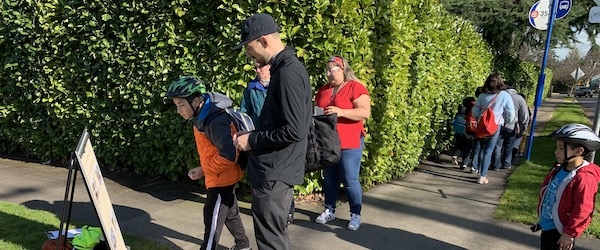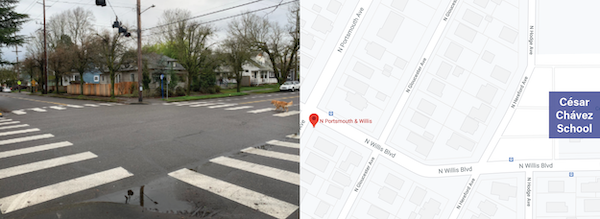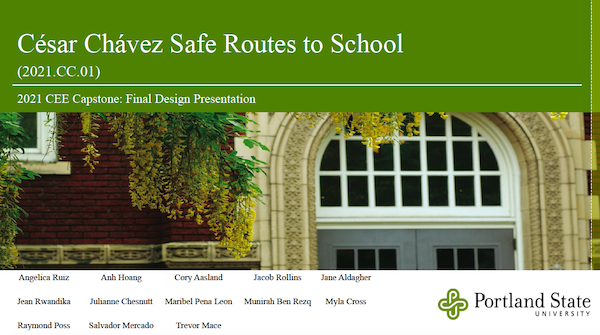Portland State Students Work with the Community to Improve Pedestrian Safety Near César Chávez School

Last year, a car driver hit a César Chávez K-8 School student at the intersection of N. Portsmouth Ave and N. Willis Blvd in Portland, OR. It underscored what parents, teachers and Portland community members have been demanding for many years: increased investment in traffic safety at schools during pick up and drop off hours.
What’s more: Portsmouth’s residents already had a lot of ideas of how to improve pedestrian safety at this intersection.
Seeking to help the community take action on these ideas, Safe Routes to School advocacy professionals William Francis and Hanna Howsmon at Community Cycling Center and César Chávez teacher Sam Balto recommended this intersection as a potential quick build project for the Better Block PSU pathway program-–a partnership between the volunteer-led group Better Block PDX and the Transportation Research and Education Center (TREC) at Portland State University that pairs transportation students with community-led projects.
“PSU students support community members with the technical aspects of infrastructure improvements–elevating and materializing their ideas by developing plans, designs, and engineering concepts. It’s a shift from the status quo with a ground-up approach, and their transportation expertise can help community members in navigating the permit process or proposing informed solutions to the city,” shared Hau Hagedorn, TREC Associate Director and Better Block PSU program lead.
Project partner William Francis added, “Community members were plugged into a process that we should not expect them to carry out solely on their own. Strong community-led work requires a mindset in which planners and engineers are looking for ways to say "yes" to community ideas as opposed to reaching for reasons to say "no".”
After undergoing development with PSU’s Urban Planning students in the Fall of 2020, this project was chosen to move onto the second phase with the Spring 2021 PSU Civil Engineering course. The team of thirteen civil engineering students was led by soon-to-be graduate Raymond Poss (now a WSDOT technician).
“We were given a blank slate to work with, and pushed outside of our comfort zone by Instructor Evan Kristof– but he was always there to bail us out if we went too deep. Unique to this engineering class, we had to learn public speaking skills working with clients and accept that not every solution fits perfectly into a box,” shared Raymond. “We experienced a lot of growth in pitching ideas, making mistakes, and supporting one another in finding solutions. Recognizing and learning to accept the limitations of real-world transportation challenges felt good in the end, and it increased our capacity to work holistically with our counterparts in planning wherever we go next.”
Pooling their collective cultural and technical knowledge, the PSU civil engineering students designed an online survey in three languages: English, Spanish, and Arabic. With the invaluable support of the Community Cycling Center, they bridged the digital divide by handing out printed half-sheet surveys through the CCC’s weekly food-delivery-by-bike program.
The residents of Portsmouth had a lot to say about what was needed to improve pedestrian safety at that intersection, and some had a clear idea of how to get it done:
- Portsmouth in general feels very unsafe. I avoid it at all costs, on bike or in a car. The area needs more refuge islands like was done on Saint Louis Ave in St Johns.
- I’ve seen multiple accidents at this intersection due to irresponsible driving. If people aren’t present, cars often don’t even stop, especially in the late evening.
- Muchos no respetan las señales de alto. [Many do not respect the stop signs.]
- A stop light or crosswalk light would be so valuable here. I have kids that walk to school everyday - and I would love to be able to send them on their own, but as of now I don't trust the drivers on Willis/Portsmouth to see them or stop for them.
- A raised table across the intersection or raised crosswalks for all 4 crossings.
- Cars heading North on Portsmouth make the right hand turn (Eastbound) on Willis try to make a turn lane around the cars that are stopped to go straight (Northbound). This is particularly dangerous when I am making the same Eastward turn on my bike (I head south on Portsmouth and turn left). They are already into their turn before they see me in the intersection. Most of them have not stopped when they have gone around the Northbound car that is stopped.
Guided by PSU engineering professor Evan Kristof and community feedback, the civil engineering students assessed the site conditions and project data to develop four pop-up alternatives along with a scoring criteria (download the full Better Block PSU presentation - PDF).
- Pop-Up Alternative - Mini-Roundabout: To slow down drivers by obstructing their path in order to ensure pedestrian safety.
- Pop-Up Alternative - Bump-outs: To slow down drivers by reducing road width in order to ensure pedestrian safety.
- Pop-Up Alternative - Raised Crosswalk: Acts like a speed bump to slow down traffic and provide a safer pedestrian crossing medium.
- Pop-Up Alternative - No Build: Maintain the current state of the intersection. (provides baseline)
The scoring criteria considered: ADA Accessibility; Aesthetics; Complexity; Constructability; Cost; Ability to Encourage Active Transportation; Data Collection; Pop-Up Longevity; Safety Improvements; Vehicle Complete Stops; Lowering Speeds; Large Vehicle Accessibility; and Visibility.
The mini-roundabout and bump-outs came pretty close in their final scores, and the team moved forward with a facility design for a pop-up mini-roundabout. They weighed the pros and cons of three different materials:
- Mixed Media (Straw Wattle; Hay Bales; Plants; Paint)
- Spray Chalk Mural
- Deck Stain and Traffic Paint Mural
The student team considered methods for manual traffic counts; how to navigate the permitting process; and developed a temporary traffic control plan. Taking the idea a step further, they laid out the potential design and solutions for a permanent mini-roundabout at N. Portsmouth Ave and N. Willis Blvd.
“We had to navigate a complicated mix of different engineering standards we needed to meet at the city, state and federal level. I was surprised to find that there was not a lot of emphasis on pedestrian safety at the federal level,” said Raymond.
Inspired by the City of Portland’s Bike-to-Books annual design contest, Raymond shared that one of the highlights of the project for him was creating a coloring sheet for community members to design and envision a mini-roundabout mural that reflects local culture and values.
Now handed off to TREC, project team partners, and the César Chávez School community, we’re seeking to work with the Portland Bureau of Transportation (PBOT) to secure a permit for a three-day community event that would allow for a temporary roundabout installation.
“We’re looking to host this community event in the Fall, before the school re-opens, so we can bring the community together to collaborate and raise awareness of traffic safety around César Chávez,” emphasized long-time Better Block PDX volunteer leader Ryan Hashagen. “This is an opportunity to showcase what the community and PSU students have to offer, and engage the city in discussing a long-term solution to pedestrian safety.”
Interested in getting involved in this community event? Contact Hau Hagedorn at hagedorn@pdx.edu.
ADDITIONAL PROJECT INFO
Download the full Better Block PSU presentation for this project here (PDF). The PSU civil engineering team included:
Photo by Sam Balto
The Transportation Research and Education Center (TREC) at Portland State University is home to the National Institute for Transportation and Communities (NITC), the Initiative for Bicycle and Pedestrian Innovation (IBPI), and other transportation programs. TREC produces research and tools for transportation decision makers, develops K-12 curriculum to expand the diversity and capacity of the workforce, and engages students and professionals through education.


